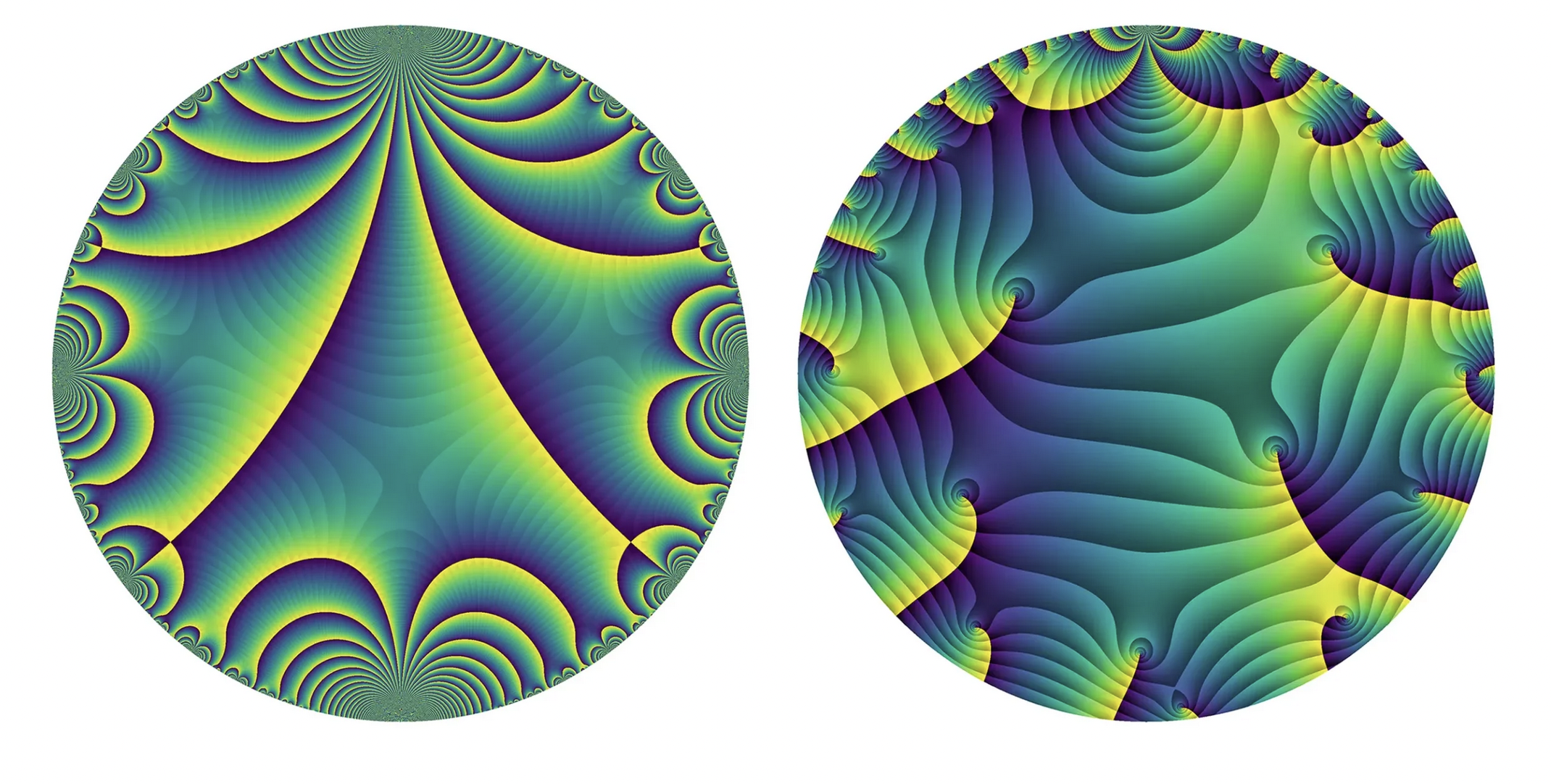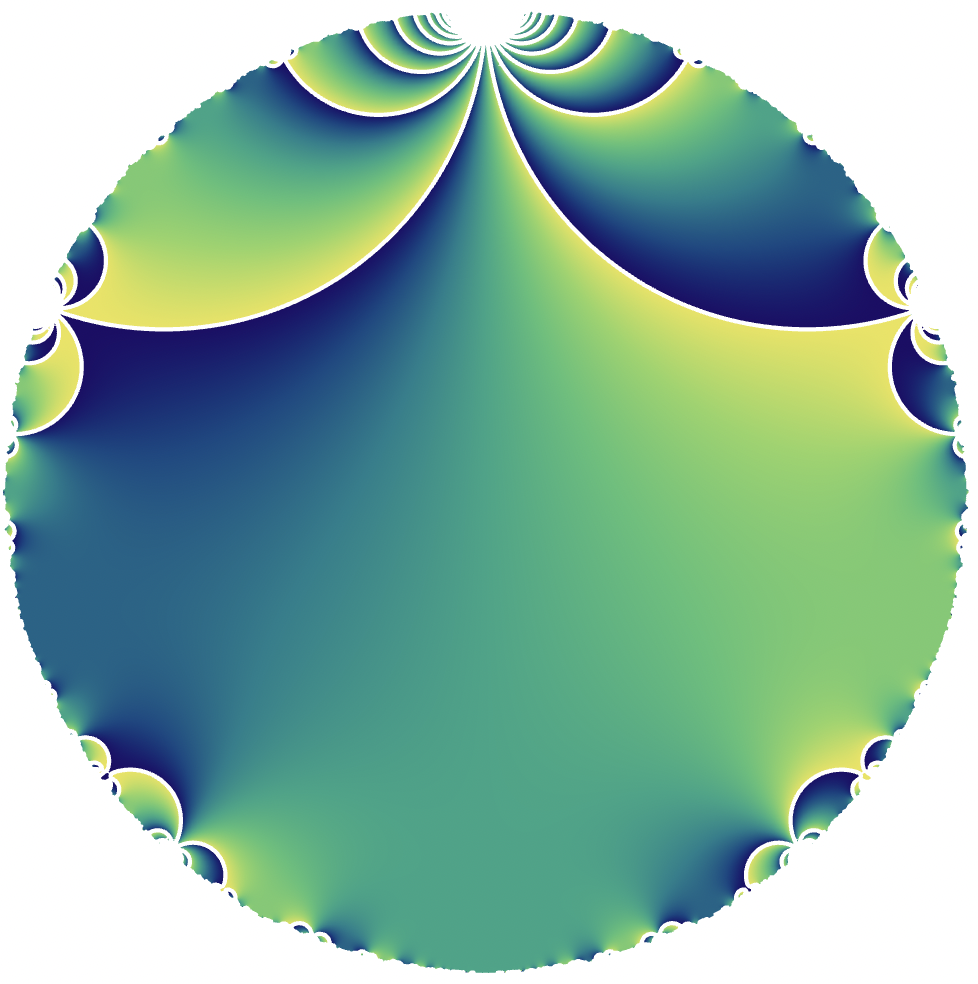Let \(f\) be a classical modular eigenform of weight \(k\), for example, \(f = \Delta\). The Ramanujan conjecture states that the Hecke eigenvalues \(a_p\) satisfy the bound
\(|a_p| \le 2 p^{(k-1)/2}.\)
A slightly fancier but cleaner way of saying this is as follows. Associated to \(f\) of weight \(k\), level \(N\) prime to \(p\) and finite order Nebentypus character \(\chi\) is a polynomial
\(X^2 – a_p X + p^{k-1} \chi(p).\)
(For \(\Delta\) one has \(\chi(p) = 1\) for all \(p\), but in general it can be some other root of unity.) This is the characteristic polynomial of Frobenius on the \(\ell\)-adic representation associated to \(f\) for \(\ell \ne p\), or the characteristic polynomial of crystalline Frobenius for \(\ell = p\). The Ramanujan conjecture is now that the Frobenius eigenvalues \(\alpha_p\) and \(\beta_p\) satisfy
\(|\alpha_p| = |\beta_p| = p^{(k-1)/2}.\)
This conjecture was famously proved by Deligne. Having determined the complex valuation of these eigenvalues, one might ask about their \(\ell\)-adic valuations as well. If \(\ell \ne p\), then since the polynomial above has constant term prime to \(\ell\), then \(\alpha_p\) and \(\beta_p\) are \(\ell\)-adic units. So the remaining case is \(p = \ell\).
When \(p = \ell\), the \(p\)-adic valuation of the two roots \(\alpha_p\) and \(\beta_p\) certainly satisfy \(v(\alpha_p), v(\beta_p) \ge 0\) and \(v_p(\alpha) + v_p(\beta) = k-1\). Given \(f\), we call these valuations the *slopes* of \(f\). The first observation is that the slopes depend on more than just the weight \(k\). For example, suppose that \(f\) is the weight \(2\) eigenform associated to a (modular) elliptic curve \(E\) with good reduction at \(p\), then either \(E\) has ordinary reduction, in which case the slopes are \(0\) and \(1\), or \(E\) has supersingular reduction, and the slopes are both \(1/2\).
Instead of fixing \(f\) and varying \(p\), one can fix both \(p\) and the tame level \(N\) and ask how the slopes vary as the weight changes. For example if \(N=1\) and \(p=2\), then the first interesting case is when \(k=12\) and \(f = \Delta\). In this case \(\tau(2) = 24\), and the two slopes are \(3\) and \(11-3 = 8\).
I’ve already tried to suggest by analogy to the Ramanujan conjecture why determining the p-adic valuations (the slopes) might naturally be an interesting question. But let me mention two other natural reasons. The first is that, from \(p\)-adic Hodge Theory, the crystalline eigenvalues \(\alpha_p\) and \(\beta_p\) determine the restriction of the \(p\)-adic Galois representation associated to \(f\) to the local Galois group at \(p\). The valuation of these slopes while containing less information than the eigenvalues themselves still tell you a lot about the \(p\)-adic representation, although determining exactly what is still a question of active and open interest. Secondly, as Coleman observed (following Hida in the case when one of the slopes is \(0\)), one can deform the Galois representations associated to these finite slope forms into continuous \(p\)-adic families of Galois representations associated to cuspidal eigenforms, which leads to the story of the eigencurve of Coleman-Mazur and beyond.
Gouvêa was one of the first people to undertake a numerical study of the roots.
In this paper where the slopes are, Gouvêa observed a number of interesting behavior of the slopes which were all somewhat mysterious. First, the slopes were almost all integers. This is not surprising when \(a_p(f) \in \mathbf{Z}\), but in general \(a_p(f)\) will be a random algebraic integer. The slopes also seemed to be distributed in a number of surprisings way. For example, although the slopes in weight \(k\) associated to \(f\) add up to \(k-1\), they tended to be concentrated in the intervals \([0,(k-1)/(p+1)]\) and \([p(k-1)/(p+1),k-1]\).
Kevin Buzzard went one step further and looked more closely at the slopes when \(N=1\) and \(p=2\). Ostensibly, according to Kevin, this was to test William Stein’s latest magma code for bugs! Kevin found that the slopes in this case satisfied a much more regular pattern. As mentioned above, when \(k=12\), there is a single eigenform whose smallest slope is \(3\). When \(k = 12 + 64\), there are six eigenforms whose smallest slopes are \(3, 7, 13, 15, 17, 25\), and when \(k = 12 + 2^{10}\), there are \(86\) forms whose slopes are
\(3, 7, 13, 15, 17, 25, 29, 31, 33, 37, 47, 49, 51, 57 \ldots \)
where all of these sequences are given explicitly by the \(2\)-adic valuation of \(2 ((3n)!/n!)^2\). Note that the Gouvêa-Mazur conjecture says that these sequences should have some initial segment in common, but in fact the Gouvêa-Mazur conjecture only implies that the slopes in weights \(16 + 2^6\) and \(16 + 2^{10}\) should be the same up to slope \(6\), and in practice they agree ridiculously further than this. This was all very mysterious. Kevin found a general algorithm which conjecturally computed by an inductive procedure all the slopes in all weights for a fixed tame level \(N\). (In what I always regarded as a missed opportunity, he did not call the paper “What the slopes are”).
In fact, Kevin’s conjectural answer required an assumption on \(N\) and \(p\) which for \(p>2\) was equivalent to asking that the local residual representations associated to all low-weight forms are locally reducible. For \(N=1\), the first case for which this does not happen is \(p = 59\), and this story is related to our counterexample to the original form of the Gouvêa-Mazur conjecture.
Kevin Buzzard was a speaker at the Arizona Winter School in 2001, and for his project he outlined a special case of his conjecture corresponding to overconvergent modular forms of weight \(k = 0\). Of course there are no classical modular cuspidal forms of weight \(k = 0\), but by Coleman’s theory there is a direct link between the questions about classical forms in all weights and overconvergent forms of finite slope in all weights. Kevin’s problem in its original formulation is described here.
I was a graduate student at the time, and although I wasn’t actually assigned to Kevin’s group, I did see his problem and had an idea which more or less amounted to the idea of using a slightly different explicit basis for this space than Kevin had considered and for which the \(U_2\) operator has a much nicer explicit form. In fact this basis was related to computations I had done in the summer of 93-94 and shortly afterwards during my first year at Melbourne uni, using what Matthew Emerton and I had come to definitely know as the “f” function
\(f = q \prod_{n=1} (1 + q^{n})^{24}.\)
(When It came to writing my paper with Kevin, I still felt strongly enough to insist we call it by this letter.)
Kevin and I put quite a bit of effort into proving his conjecture for more general \(k\), still with \(N=1\) and \(p=2\), but only succeeded in a few cases, including \(k = -12\), but also \(k = -84\) which was somewhat randomly chosen as a case where our approach failed but only by a little bit which could be overcome. There are a few other cases where \(X_0(p)\) has genus zero and one can do something similar, but otherwise very little progress was made on these conjectures in this situation.
There are a plethora of related conjectures which also came out (at least indirectly) from similar calculations. For example, Kevin’s algorithm certainly always produces integers, so, in light of the \(p\)-adic theory, there is the natural question of whether a crystalline representation with Hodge-Tate weights \([0,k-1]\) for \(k\) even whose residual representation is reducible always has finite slope, Then there are questions of the exact relationship between the slope and the Galois representation, and so on.
Concerning the exact slopes themselves, perhaps the biggest advance over time were refinements of Kevin’s conjecture. The Ghost Conjecture, formulated by Bergdall and Pollack, is some “master conjecture” of a combinatorial nature generalizing a number of previous conjectures concerning the slopes of classical overconvergent modular forms over the centre of weight space. (Although, perhaps amusingly, it’s not clear that these conjectures do actually imply Buzzard’s original conjecture.)
Now cut to the present day. In a recent preprint, Ruochuan Liu, Nha Xuan Truong, Liang Xiao, Bin Zhao have now proved all of these conjectures, at least up to some genericity hypotheses (excluding the case \(N=1\) and \(p=2\)!). The authors certainly employ technologies that didn’t exist 20 years ago (\(p\)-adic Langlands, for example), but that was not the only obstruction to previous progress: the paper contains a number of very original and clever ideas. Very amazingly and satisfyingly, it resolves a large number of the open problems discussed above, including Gouvêa’s conjectures about the distribution of slopes, the integrality properties of slopes for locally reducible representations, and even a version of the Gouvêa-Mazur conjecture. It is also satisfying that the arguments use \(p\)-adic local Langlands, given that some of the initial computations of slopes served at least in part as inspiration for some aspects of this program. I myself have not really worked on this circle of problems for almost 20 years but I am still very happy to see these questions answered!






